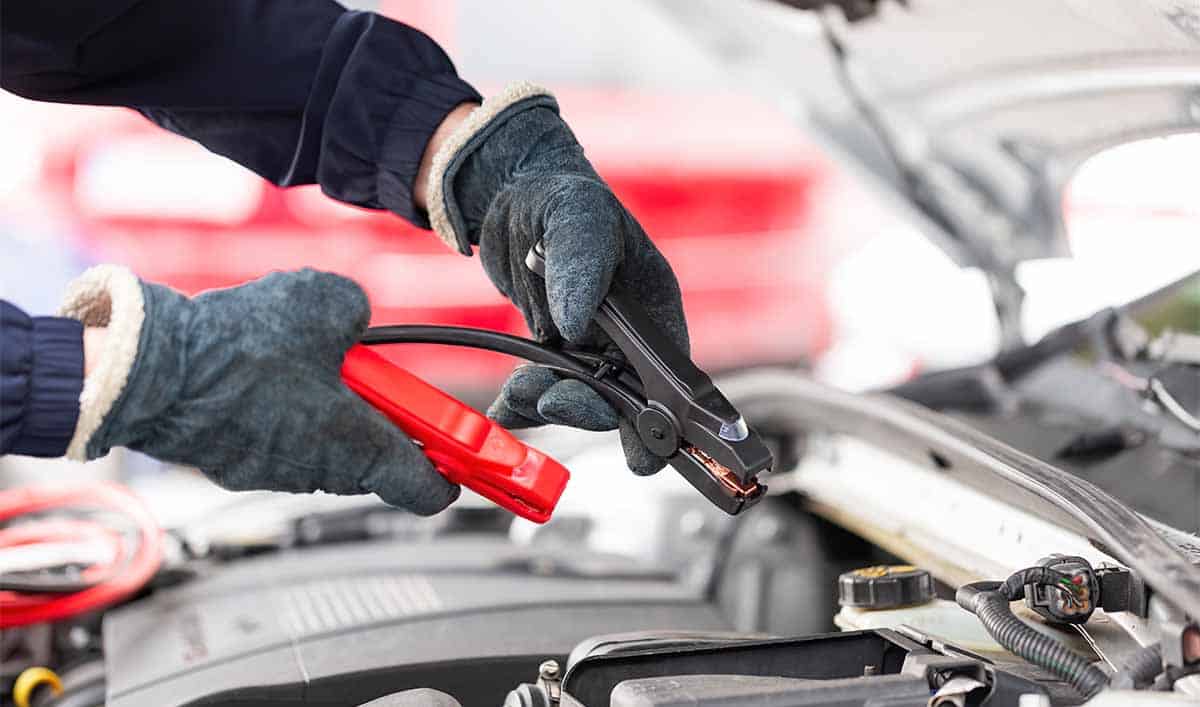Electric vehicles (EVs) have become increasingly popular in the US, with about 65.3% of households (up from 48%) that previously owned an EV going for another one. However, many EV owners opt for an electric vehicle and a gasoline-powered one. So, if one fails, the other works. But can you jump a gasoline-powered car with a Tesla?
You can jump a normal car with a Tesla using the 12-volt battery. However, Tesla warns against it because the process of jump-starting the regular car can damage the Tesla’s battery. Lead acid batteries are not the same, and Tesla 12V batteries don’t meet the power requirements of internal combustion engine (ICE) batteries. Therefore, the risks may not be worth it.
Charging a gasoline-powered vehicle with a Tesla is fairly straightforward. However, you should be cautious. In this article, I’ll discuss jumping a gas-powered car with a Tesla, the dos and dont’s, and why it sometimes fails.

Gain a comprehensive understanding of the inner workings of a Tesla electric car with my jargon-free guide, suitable for readers of all technical backgrounds.
What Would Happen if You Tried Jumping a Car With a Tesla?
When you have a gas-powered car with a flat battery, or you encounter someone stranded on the side of the road, you may be tempted to use your Tesla to jump their car, as Tesla uses a lithium-ion battery to charge the main 400v-battery, so it’s always fully charged.
However, if you tried jumping a car with a Tesla car, you’d be putting a strain on the 12v battery. The ICE car battery is also 12v, but it needs a high current to start the car. Any attempt to jump an ICE battery, its high voltage demand may not be met with the low current from the Tesla 12v battery.
The 12v Tesla battery is responsible for running electronics, but the current may not be sufficient to recharge the ICE battery.
If the Tesla manages to recharge the ICE battery, the electric surges between the DC/DC converter may damage the battery. This will leave your Tesla without critical functions, such as the computer systems, lights, and windows, and other electrical components will stop working.
Should you find yourself in this situation you may need to reboot your Tesla once any battery damage issue has been resolved.
Why You Shouldn’t Jump an ICE Car With a Tesla
Despite the risks associated with using the 12v Tesla battery to charge the internal combustion engine (ICE) car’s battery, some people still do it. You may be in a tight spot, and the only way out is to use your Tesla. Some people have done it, and their Tesla battery didn’t suffer any damage.
But can you jump an ICE car with a Tesla? While you technically can, you should probably focus on whether you should do it.
When you jump an ICE car with a Tesla, you strain the EV 12v battery. You should also be concerned about the effect on the DC/DC converter. On its own, the 12v battery on Tesla cars is not designed to produce enough amps to run the starter motor.
The stress on the 12v battery may be more than it can handle. Fortunately, if everything is running correctly, the 12v battery is always charged. So, if you have no choice but to use your Tesla, you won’t need to run it when you charge the ICE battery.
Some people argue that it’s safer to disconnect the 12v battery from the 400v lithium-ion battery. This way, you don’t create a sudden surge in current, with the DC/DC inverter attempting to interpret the reason behind the sudden spike.
These conflicting arguments make it difficult for Tesla owners to determine the best approach for jump-starting another car. However, almost everyone agrees that the risk of damage to the Tesla battery is higher when you attempt to jump the other battery in winter.
During winter, Tesla’s performance, like other electric vehicles, usually takes a hit. The battery range drops, so using the 12v battery to charge a secondary battery may not be a good idea. Unfortunately, this is also the season when many ICE car batteries fail.
For more information, here’s a helpful YouTube video on how to jump-start a car with a Tesla:
How To Jump an ICE Battery With a Tesla
If you have no option but to use your Tesla to charge an internal combustion engine, you first need to access the 12v battery. Position your Tesla where the portable jump starter can reach the Tesla battery and the ICE battery.
The terminals are hidden, and it’s sometimes hard to fit the positive cable on the right terminal because of its position under the front cover:
- Connect the negative jumper cable to the negative terminal on the Tesla 12v battery.
- Now connect the black negative cable to the negative terminal on the dead battery.
- Connect the red cable to the positive on the bad battery.
- Place the other end of the red cable on the positive on the Tesla battery.
- Give the Tesla battery a few minutes to charge the bad battery.
- Start the gas car. It should start running.
Now remove the jump cable in reverse order to keep to prevent short circuits:
- Remove the red cable from the Tesla battery.
- Take the positive from the ICE car.
- Remove the negative from the gas car.
- Lastly, remove the negative cable on the Tesla.
Always ensure the cables don’t touch any part of the car when connecting and disconnecting because you don’t want to mess with the electrical circuit. You should also avoid connecting the jumper cables to the wrong terminals.
If you place the red cable where the black should go, the electrical current running through the cables will be too high. If this happens, the cables may melt, or you could start a fire.

How To Jump a Tesla 12v Battery
Although it rarely happens, the 12v Tesla battery can go flat. However, some Tesla owners, especially those with the earlier Model X and Model Y, have complained that the 12-volt batteries in these cars die fast.
In February 2021, Elon Musk said that Tesla was transitioning to 12-volt lithium-ion batteries in new Model S and Model X vehicles. These batteries have more capacity, and the life cycle rivals that of the main 400-volt battery pack.
A dead 12v battery in the Tesla can be crippling. You cannot unlock the doors, and the computer systems won’t power up. Often, the 12v battery runs flat when it gets to the end of its lifecycle or when the main battery pack runs low.
The 12v battery usually goes flat within 24 hours when the main battery pack stops charging it. When this happens, Tesla warns against using another car to charge the 12v battery. However, you’ll probably discover Tesla owners who jump the battery with another Tesla without any issues.
Use a 12v Charger On The Charging Points Or 12v Battery.
You can jump the 12v Tesla battery with a 12v charger if you have access to a charging point or the battery. The easiest way to access the battery is through the car’s frunk. How you open it will depend on your Tesla model.
Some Teslas have hidden 12v charging points in the towing eye cover. You simply need to open the cover, pull the wires, and connect them to the 12v external battery charger. You will get enough charge to open the frunk.
You can now remove the cables, starting with black, then red, before moving them to the battery.
When connecting the jump cables to the battery;
- Connect the red cable to the positive on the 12v battery.
- Next, connect the black to the negative terminal.
When the battery charges, the computer systems will come on. When removing the cables, start with the black (-ve) followed by the red (+ve).
When you start charging the battery, give it a few minutes to juice up before turning on any of the electrical systems. This will prevent glitches that are likely to occur because all the systems will attempt to power and recover simultaneously, yet the battery may not have sufficient power to meet the sudden demand.
If your Tesla doesn’t have hidden charging points in the tow eye cover, you can access the battery by popping the hood of the front trunk using the emergency release cords hidden in the front wheel arches.
Charge The Main Battery Pack.
If the 12v battery died because the main battery ran low, you can also solve the problem by charging the main battery. However, this only works if you are close to a charging station. When the main battery runs so low, it will take longer to charge.
A supercharger will not speed the process, so it is best to avoid it, especially if you have other people waiting to use it. Instead, you can use the standard electric plug and leave it to charge the main battery.
If you start by charging the 12v battery, you should disconnect it before charging the 440-volt battery.
Fortunately, from 2022, Tesla replaced the 12v lead batteries with lithium-ion batteries. These batteries have a ton of juice, minimizing their risk of running low.
Conclusion
The discussion of whether to jump-start a car with a Tesla is a little complex because you have a difficult decision to make. Do you jump the battery of the ICE car and risk expensive repairs on your Tesla? Or do you take the risk since others have done it without issues?
Tesla has come out strongly against doing this because the computer system can’t interpret the surge in electricity demand. So, if you can avoid it, it’s best to do so. However, if you have to, know how to do it safely to avoid damaging your Tesla.
- Tesla Charger Installation Cost (Home Setups) - March 1, 2024
- Tesla Phone Key Disconnected (Troubleshooting Guide and Quick Fixes) - March 1, 2024
- Tesla FSD 12 (Explained) - March 1, 2024